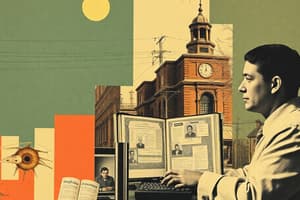Podcast
Questions and Answers
Which topic relates to microeconomics?
Which topic relates to microeconomics?
- The relationship between the inflation rate and changes in the quantity of money.
- A firm’s decision about how many workers to hire. (correct)
- The effect of government regulations on auto emissions.
- The impact of higher national saving on economic growth.
The mayor’s question about how much vaccine will be in stock requires which type of assessment?
The mayor’s question about how much vaccine will be in stock requires which type of assessment?
- Descriptive assessment.
- Positive assessment. (correct)
- Normative assessment.
- Qualitative assessment.
If the city charges $25 per shot, which of the following questions is normative?
If the city charges $25 per shot, which of the following questions is normative?
- Should the city engage in such a scheme? (correct)
- What will be the profit per shot?
- How many people will pay?
- How many doses will be available?
In discussing trade-offs, what does the production possibilities frontier illustrate?
In discussing trade-offs, what does the production possibilities frontier illustrate?
What does John Maynard Keynes suggest is necessary for the master-economist?
What does John Maynard Keynes suggest is necessary for the master-economist?
How does Keynes describe the nature of economics as a subject?
How does Keynes describe the nature of economics as a subject?
What is the primary purpose of studying the present in light of the past according to Keynes?
What is the primary purpose of studying the present in light of the past according to Keynes?
Which of the following best defines opportunity cost?
Which of the following best defines opportunity cost?
What does the production possibilities frontier illustrate?
What does the production possibilities frontier illustrate?
Why are scientific methods important in the study of social sciences?
Why are scientific methods important in the study of social sciences?
In which capacity does Keynes suggest an economist must be 'aloof and incorruptible'?
In which capacity does Keynes suggest an economist must be 'aloof and incorruptible'?
What does Keynes imply about the breadth of an economist's focus?
What does Keynes imply about the breadth of an economist's focus?
What is one purpose of microeconomics?
What is one purpose of microeconomics?
Which statement describes a positive statement in economics?
Which statement describes a positive statement in economics?
What is the primary focus of macroeconomics?
What is the primary focus of macroeconomics?
Why do economists build models and assumptions?
Why do economists build models and assumptions?
Which of the following is an example of a normative statement?
Which of the following is an example of a normative statement?
What do conflicting advices among economists often stem from?
What do conflicting advices among economists often stem from?
What is represented in the circular flow diagram?
What is represented in the circular flow diagram?
Which of these is a role of economists as policy makers?
Which of these is a role of economists as policy makers?
An example of a positive statement is:
An example of a positive statement is:
What is an economic model best defined as?
What is an economic model best defined as?
In the circular-flow diagram, who are the sellers in the markets for the factors of production?
In the circular-flow diagram, who are the sellers in the markets for the factors of production?
A point inside the production possibilities frontier signifies which of the following?
A point inside the production possibilities frontier signifies which of the following?
If consumers begin to prefer hot dogs due to new health benefits, the result would likely be?
If consumers begin to prefer hot dogs due to new health benefits, the result would likely be?
Which of the following topics does NOT fall under microeconomics?
Which of the following topics does NOT fall under microeconomics?
In the debate between Peter and Christ regarding tax fairness, which aspect might influence the argument?
In the debate between Peter and Christ regarding tax fairness, which aspect might influence the argument?
What type of argument would support the idea that your roommate should change her behavior?
What type of argument would support the idea that your roommate should change her behavior?
Which viewpoint would justify that you should be the one to buy earphones?
Which viewpoint would justify that you should be the one to buy earphones?
When discussing disagreement in tax fairness between Peter and Christ, which factor is most likely considered?
When discussing disagreement in tax fairness between Peter and Christ, which factor is most likely considered?
What does a movement along the production possibilities frontier imply?
What does a movement along the production possibilities frontier imply?
What do economists attempt to achieve by making assumptions and building models?
What do economists attempt to achieve by making assumptions and building models?
What distinguishes microeconomics from macroeconomics?
What distinguishes microeconomics from macroeconomics?
In the class activity about the loud music, what is a primary normative statement made?
In the class activity about the loud music, what is a primary normative statement made?
What did the discussion about earphones reveal about efficiency in economic terms?
What did the discussion about earphones reveal about efficiency in economic terms?
What is an example of a positive statement in the context of the loud music exchange?
What is an example of a positive statement in the context of the loud music exchange?
Which statement most accurately represents normative economic thinking?
Which statement most accurately represents normative economic thinking?
What conclusion can be drawn from the discussion of opportunity costs?
What conclusion can be drawn from the discussion of opportunity costs?
What is the core principle behind the Production Possibility Frontier?
What is the core principle behind the Production Possibility Frontier?
Flashcards
Scientific Method
Scientific Method
A systematic approach to understanding and explaining phenomena by making observations, formulating hypotheses, testing them through experiments or data analysis, and drawing conclusions based on evidence.
Assumptions and Models
Assumptions and Models
Models are simplified representations of reality, used to understand complex situations. They rely on assumptions to focus on specific elements.
Opportunity Cost
Opportunity Cost
The value of the best alternative foregone when making a choice. It reflects the cost of choosing one option over another.
Production Possibilities Frontier (PPF)
Production Possibilities Frontier (PPF)
Signup and view all the flashcards
Movement of money and products/services
Movement of money and products/services
Signup and view all the flashcards
Individual Value
Individual Value
Signup and view all the flashcards
Market Value
Market Value
Signup and view all the flashcards
Surplus and Deficit
Surplus and Deficit
Signup and view all the flashcards
Circular Flow Diagram
Circular Flow Diagram
Signup and view all the flashcards
Economic Models
Economic Models
Signup and view all the flashcards
Positive Statement
Positive Statement
Signup and view all the flashcards
Normative Statement
Normative Statement
Signup and view all the flashcards
Production Possibilities Frontier
Production Possibilities Frontier
Signup and view all the flashcards
Microeconomics
Microeconomics
Signup and view all the flashcards
Macroeconomics
Macroeconomics
Signup and view all the flashcards
Economists as Policy Makers
Economists as Policy Makers
Signup and view all the flashcards
Economists as Scientists
Economists as Scientists
Signup and view all the flashcards
Economic Modeling
Economic Modeling
Signup and view all the flashcards
Broken Window Fallacy
Broken Window Fallacy
Signup and view all the flashcards
Efficiency
Efficiency
Signup and view all the flashcards
Equity
Equity
Signup and view all the flashcards
Fairness over Efficiency
Fairness over Efficiency
Signup and view all the flashcards
Inefficient Production
Inefficient Production
Signup and view all the flashcards
Efficient Production
Efficient Production
Signup and view all the flashcards
Economic Growth
Economic Growth
Signup and view all the flashcards
Profit
Profit
Signup and view all the flashcards
Study Notes
Course Information
- Subject: ECO202: Principles of Microeconomics
- Instructor: Vrak Thanit
- Textbook: Principles of Microeconomics by N. Gregory Mankiw (10th Edition)
- Chapter 2: Thinking Like an Economist
Chapter 2: Thinking Like an Economist - Table of Contents
- Discussion
- Review
- Class Activities
- Homework & Exercises
Chapter 2: Thinking Like an Economist - Discussion Points
- Scientific method in social science
- Connection between assumptions and models in real-world applications
- Calculating opportunity cost
- Understanding production possibility frontiers
- Explaining how money and products/services move around the world
Chapter 2: Thinking Like an Economist - Key Concepts
- Economists as Scientists: develop models, build assumptions to simplify the world, create positive statements (description of how the world is), use data
- Economists as Policy Makers: establish policies to improve the economy, make normative statements (telling how the world should be), opinions, recommendations for change, conflicting advice.
- Micro vs. Macro Economics: Macroeconomics is the study of the whole economy, including trends and forces, while Microeconomics examines decision making at the individual level (e.g., households, firms).
- Positive vs. Normative Statements: Positive statements describe the world as it is, while normative statements prescribe how the world should be (e.g., "inflation increases," vs. "inflation should be lowered")
Chapter 2: Thinking Like an Economist - Learning Outcomes
- Economists as Scientist: Build models (use assumptions to simplify); Make positive statements (describe the world based on observable facts); use data to form conclusions. Use Circular Flow and Production Possibilities Diagrams.
- Economists as Policy Makers: Establish policies to improve the economy; Make normative statements (prescriptive, what the world should be like); Opinions and recommendations may vary due to conflicting opinions/judgments.
- Micro vs. Macro Summary: Micro focuses on individual actors like households and firms, while macro looks at forces and trends impacting the entire economy.
Chapter 2: Thinking Like an Economist - Class Activities
- Production Possibility Frontier (PPF) activities: illustrate trade-offs through a game
- Thinking Like an Economist (Broken Window Fallacy) activity: explain/explore concept
- Positive vs. Normative Statements activity: identify, contrast, and/or create examples
- Disagreement in Policies activity: analyzing different perspectives/ viewpoints on a policy issue
- Economic Model Application Activity: (examples in the quick quiz on models include production possibility frontier, circular flow, etc.)
- Quick Quiz: identify economic models, types of statements, and economic concepts, including topics in microeconomics and macroeconomics
Chapter 2: Thinking Like an Economist - Homework & Exercises: Quick Quizzes
- Economic Models: Definition/ characteristics
- Circular Flow diagrams: describe basic functions
- Production Possibilities Frontier: Understanding efficiency
- Micro vs. Macro Economics: distinguishing between the two economic perspectives
- Positive vs. Normative statements: distinguishing between the two types of statements
- Classify economic topics: Micro or Macro
- Positive assessment vs. Normative assessment: application of the two types of statement analysis
- Homework Questions for Review (model description, efficiency, conflicting advice)
- Problems & Applications (trade-offs, production possibility frontiers, policy changes, and consequences)
Studying That Suits You
Use AI to generate personalized quizzes and flashcards to suit your learning preferences.




